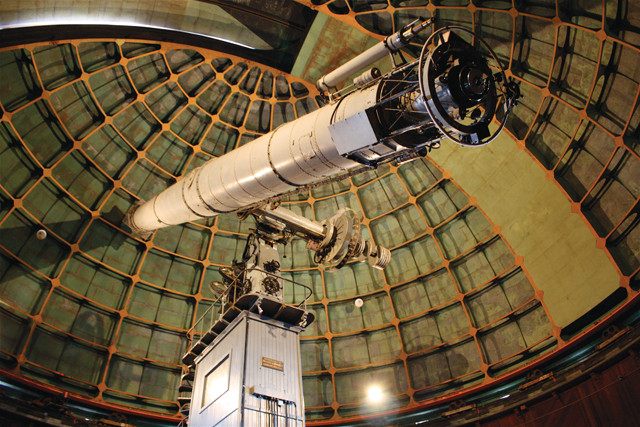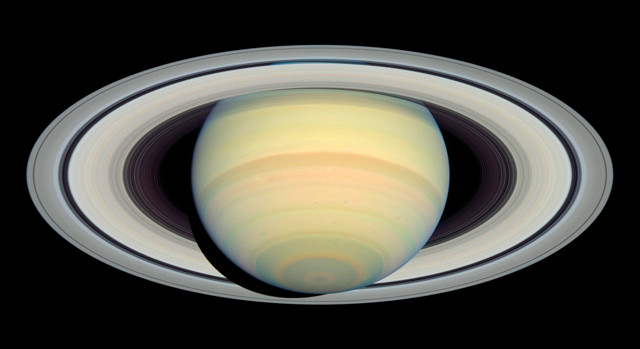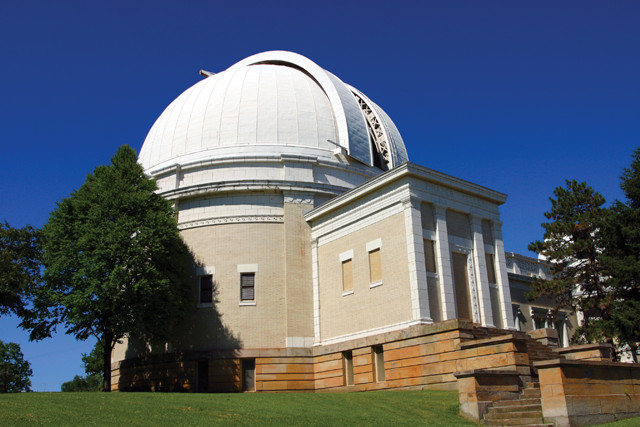
by Erin Wayman Tuesday, June 21, 2016

James Edward Keeler designed a spectroscope for the Lick Observatory's 36-inch (91-centimeter) refracting telescope. Credit: ©Naotake Murayama, Creative Commons Attribution 2.0 Generic.
On April 9 and 10, 1895, astronomer James Edward Keeler snapped the most important photographs of his life. With a 13-inch (33-centimeter) refracting telescope, Keeler captured proof that Saturn’s rings were not solid disks, but instead a collection of particles revolving around the planet. The discovery put to rest a question that astronomers had been pondering for more than two centuries.
Today, scientists agree that Saturn’s rings are mainly composed of dust grain- to boulder-sized clumps of water-ice. But the first person to gaze upon the rings didn’t even recognize them as rings. In 1610, Galileo noticed Saturn wasn’t like other planets. Two smaller planets or moons, one on each side of Saturn, appeared to be almost touching the planet. Over the next several years, Galileo’s observations of Saturn became confusing: The “moons” disappeared and then reappeared.

Saturn's rings are composed of billions of water-ice particles. Credit: NASA, ESA and E. Karkoschka (University of Arizona).
Dutch astronomer Christiaan Huygens solved the mystery of the disappearing moons in the 1650s. Based on his own observations, Huygens declared that a solid, unattached ring surrounded Saturn. The vanishing moons that Galileo witnessed were the result of changes in Earth’s orientation relative to the plane of Saturn’s ring, which affected how the ring looked to Earth-based observers.
Over the next century, astronomers continued to contemplate Saturn’s ring. By the end of the 18th century, the predominant hypothesis was that Saturn was encircled by several solid rings. In 1859, however, Scottish physicist and mathematician James Clerk Maxwell demonstrated in more than 60 pages of calculations that solid rings would not be stable, eventually being torn apart by tidal forces. “The only system of rings which can exist,” Maxwell wrote in an essay, “is one composed of an indefinite number of unconnected particles, revolving around the planet with different velocities according to their respective distances.”
Thirty-six years later, James Edward Keeler provided empirical confirmation of Maxwell’s computations.
Keeler was among a new crop of astronomers who applied the theories of physics to their work — now called astrophysicists. Keeler’s specialty was spectroscopy; he measured the wavelengths of light emitted by heavenly bodies to learn more about their composition and behavior. In 1888 — seven years after completing a bachelor’s degree in physics at Johns Hopkins University — Keeler joined the staff of the University of California’s new Lick Observatory, located atop Mount Hamilton in the Diablo Range east of San Jose, and designed a spectroscope for the observatory’s 36-inch (91-centimeter) refracting telescope. He spent much of his time studying clouds of gas called nebulae. But while at Lick, Keeler made his first discovery related to Saturn’s rings: He found a 325-kilometerwide gap within the outermost large ring, the A Ring. Today, the gap is known as the Encke Gap in honor of German astronomer Johann Encke, who also studied Saturn’s rings.
In 1891, Keeler brought his spectroscopic expertise to the East Coast when he took over as director of the Allegheny Observatory, operated by Western University of Pennsylvania (now called the University of Pittsburgh). As he did at the Lick Observatory, Keeler designed a special spectroscope for the observatory’s refracting telescope, and once again, aimed his instruments at Saturn.

Keeler was director of the Allegheny Observatory from 1891 to 1898. Credit: Tom Murphy VII.
On April 9 and April 10, 1895, Keeler took spectrographic photos of Saturn and its rings. As Saturn’s rings moved relative to Keeler’s spectroscope on Earth, the wavelengths of light emitted by the rings changed. This is known as the Doppler Effect, which Keeler used to calculate the velocity of the rings. He determined that the rings’ inner edge traveled faster than the outer edge. This was exactly what Maxwell had predicted: If Saturn’s rings were composed of numerous independent particles, they would travel at different speeds, such that the particles closest to Saturn would have the greatest velocities. Thus, Keeler’s work was “the first direct proof of the correctness” of Maxwell’s hypothesis, Keeler reported that spring in the Astrophysical Journal, a journal he had co-founded with astronomer George Ellery Hale.
Unfortunately, Keeler’s career was cut short. In 1900, he died from a weak heart at the age of 42. But Keeler will forever be connected to Saturn’s rings: His ashes are interned at the Allegheny Observatory, where he made his most famous discovery.
© 2008-2021. All rights reserved. Any copying, redistribution or retransmission of any of the contents of this service without the expressed written permission of the American Geosciences Institute is expressly prohibited. Click here for all copyright requests.